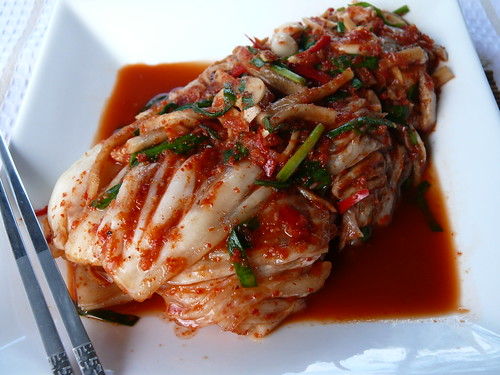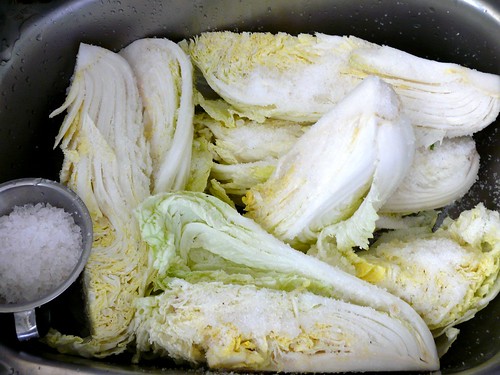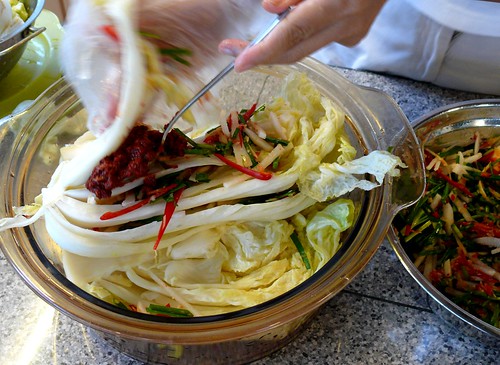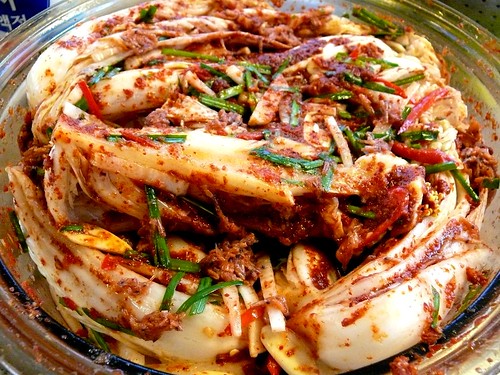"We Korean men can do without our wives but we cannot live a day without kimchi," said a Korean expatriate to my friend. I would've told him: "Your wife can do without you and kimchi but not money and that's why you are slogging it out here."

Kimchi is like durian or cheese or anything strong-smelling or tasting: you either hate it or love it . Kim chi has a complex taste of sour, hot, salty, savory-sweet and a punch-to-the-nose pungency from the garlic and shrimp sauce. Best of all, I'm told by Young Sook, my previous neighbor who was from Seoul, kimchi is like yogurt, it keeps you slim and your digestive system healthy. I don't quite know how that works because she spoke in limited Malay and I spoke to her in English but I like the "keeps you slim" part. Young Sook is very slim and pretty.
Once in a few months, Young Sook and a couple of her countrywomen would get together to make kimchi. They would come with sacks of cabbage and sit on the floor, cutting and kneading the pickles in large tubs and basins and at the end of the day, each would take home a share. I get a tupperware of it too, lucky me. The Koreans really take their pickled veg seriously. No meal would be without some sort of kimchi. I don't know if it's because of this, and I could be wrong, but I've found Koreans, especially the older ones, to be very ethnocentric about their food, and not venturous with other cuisine except for hamburgers.
Other than chinese cabbage kimchi, almost all other veg can be pickled too. Young Sook sometimes made instant kimchi using chinese mustard greens or choysum because this veg can be pickled and eaten immediately. Years ago, I lived in Seoul for 3 weeks under a training program sponsored by The Korean Development Bank and ate in the bank's cafeteria everyday. Lunch was very simple, with a lot of simple veg pickles (hardly any meat) and many people from other Asian countries hated the food. Most of my coursemates lived on instant noodles in their hotel rooms. What a pity, because Korean food is one of the best and least appreciated cuisine. The Koreans just don't bother to dress up their dishes like the Japanese. I sometimes find Japanese food very pretentious. A coddled egg in a pretty ceramic bowl with a sprinkle of black sesame is considered delicious and exquisite. Serve the same thing in a Chinese or Korean restaurant and risk being beaten up. Try this: if they serve kimchi cut into small slivers on some fancy hand-made ceramic plate in a Jap resaturant, you'd go; "Ah so, can I have some more?" But, I'm a sucker for pretty pretentious things too so I do love Jap food, just in case any of you want to take me out for a meal.
Don't just eat kimchi as a side dish. You can fry it with pork, or rice, or make a quick soup by adding canned tuna, tofu and egg.

Kimchi
2 Chinese cabbage, about 2 kg each, quartered lengthwise
1 large (500g) chinese radish (daikon), in thin juliene strips
6 to 8 large chilies, sliced thinly
1 cup spring onions or garlic chives, in 3 cm lengths
2 bulbs garlic, peeled
1 large brown onion, sliced
5 cm piece of ginger, peeled
1 1/2 cups coarse salt
1 1/2 cups gochugaru #(Korean ground chili pepper)
1/2 cup fish sauce*
1/2 cup fermented shrimps (use cincaluk)*
2 T glutinous rice flour
1 cup water
1/4 cup fine sugar
msg (optional)

Kimchi is like durian or cheese or anything strong-smelling or tasting: you either hate it or love it . Kim chi has a complex taste of sour, hot, salty, savory-sweet and a punch-to-the-nose pungency from the garlic and shrimp sauce. Best of all, I'm told by Young Sook, my previous neighbor who was from Seoul, kimchi is like yogurt, it keeps you slim and your digestive system healthy. I don't quite know how that works because she spoke in limited Malay and I spoke to her in English but I like the "keeps you slim" part. Young Sook is very slim and pretty.
Once in a few months, Young Sook and a couple of her countrywomen would get together to make kimchi. They would come with sacks of cabbage and sit on the floor, cutting and kneading the pickles in large tubs and basins and at the end of the day, each would take home a share. I get a tupperware of it too, lucky me. The Koreans really take their pickled veg seriously. No meal would be without some sort of kimchi. I don't know if it's because of this, and I could be wrong, but I've found Koreans, especially the older ones, to be very ethnocentric about their food, and not venturous with other cuisine except for hamburgers.
Other than chinese cabbage kimchi, almost all other veg can be pickled too. Young Sook sometimes made instant kimchi using chinese mustard greens or choysum because this veg can be pickled and eaten immediately. Years ago, I lived in Seoul for 3 weeks under a training program sponsored by The Korean Development Bank and ate in the bank's cafeteria everyday. Lunch was very simple, with a lot of simple veg pickles (hardly any meat) and many people from other Asian countries hated the food. Most of my coursemates lived on instant noodles in their hotel rooms. What a pity, because Korean food is one of the best and least appreciated cuisine. The Koreans just don't bother to dress up their dishes like the Japanese. I sometimes find Japanese food very pretentious. A coddled egg in a pretty ceramic bowl with a sprinkle of black sesame is considered delicious and exquisite. Serve the same thing in a Chinese or Korean restaurant and risk being beaten up. Try this: if they serve kimchi cut into small slivers on some fancy hand-made ceramic plate in a Jap resaturant, you'd go; "Ah so, can I have some more?" But, I'm a sucker for pretty pretentious things too so I do love Jap food, just in case any of you want to take me out for a meal.
Don't just eat kimchi as a side dish. You can fry it with pork, or rice, or make a quick soup by adding canned tuna, tofu and egg.

Kimchi
2 Chinese cabbage, about 2 kg each, quartered lengthwise
1 large (500g) chinese radish (daikon), in thin juliene strips
6 to 8 large chilies, sliced thinly
1 cup spring onions or garlic chives, in 3 cm lengths
2 bulbs garlic, peeled
1 large brown onion, sliced
5 cm piece of ginger, peeled
1 1/2 cups coarse salt
1 1/2 cups gochugaru #(Korean ground chili pepper)
1/2 cup fish sauce*
1/2 cup fermented shrimps (use cincaluk)*
2 T glutinous rice flour
1 cup water
1/4 cup fine sugar
msg (optional)
# reduce to 1 cup if you don't want it too hot.
* for a less pungent kimchi, use 1 cup fish sauce and omit the fermented shrimps. I prefer to use Thai or Vietnamese fish sauce. The Korean ones are too salty and are usually in plastic bottles and sometimes give the kimchi a plastic smell. You may have to add some salt to the kimchi if you use the Thai or Viet fish sauce.

1. Put cabbage into a large tub (I put them into my kitchen sink) and add the coarse salt, rubbing it into the leaves. Put a heavy weight (such as a wooden cutting board) over the cabbage and leave 4 to 5 hours.

2. Put the garlic, ginger, chillies and onion (leave some garlic and chillies unchopped if like) into a food processor and whizz into a fine paste.
3. Mix the chili paste (2) with the chinese radish, chives/spring onions, the unprocessed chilies and garlic in a bowl.
4. Mix the chili powder, glutinus rice flour, sugar and 1 cup water into a watery paste, add the fish sauce and shrimp paste and add this into the radish mixture (3), mixing well. Add 1/2 to 1 t msg if using (I don't).
5. After 5 hours, the cabbbage would have wilted. Wash 3x and squeeze out the water.

6. Spoon the chili-radish mixture in between the leaves of the cabbage and place into a clean dry glass container (use a clean plastic bag to protect your hands from the hot chilies). Put a plate over it to weigh it down, and cover. Leave for 1/2 day and then put into the fridge for 4 to 5 days before eating.

* for a less pungent kimchi, use 1 cup fish sauce and omit the fermented shrimps. I prefer to use Thai or Vietnamese fish sauce. The Korean ones are too salty and are usually in plastic bottles and sometimes give the kimchi a plastic smell. You may have to add some salt to the kimchi if you use the Thai or Viet fish sauce.

1. Put cabbage into a large tub (I put them into my kitchen sink) and add the coarse salt, rubbing it into the leaves. Put a heavy weight (such as a wooden cutting board) over the cabbage and leave 4 to 5 hours.

2. Put the garlic, ginger, chillies and onion (leave some garlic and chillies unchopped if like) into a food processor and whizz into a fine paste.
3. Mix the chili paste (2) with the chinese radish, chives/spring onions, the unprocessed chilies and garlic in a bowl.
4. Mix the chili powder, glutinus rice flour, sugar and 1 cup water into a watery paste, add the fish sauce and shrimp paste and add this into the radish mixture (3), mixing well. Add 1/2 to 1 t msg if using (I don't).
5. After 5 hours, the cabbbage would have wilted. Wash 3x and squeeze out the water.

6. Spoon the chili-radish mixture in between the leaves of the cabbage and place into a clean dry glass container (use a clean plastic bag to protect your hands from the hot chilies). Put a plate over it to weigh it down, and cover. Leave for 1/2 day and then put into the fridge for 4 to 5 days before eating.


23 comments:
Very interesting.. I love Korean BBQ and the glass noodles thingy, but never really ventured other dish yet. Thanks to ur post, i know more about kimchi today! :-) Did you joined ur neighbours to make these?
OMG, from scratch? I bow down to you. :)
you cracked me up on the pretentious part. Honestly, being a practical Chinese, I am all for simple and delicious food. I rather my food be delicious rather than pretty. kimchi is definitely my kind of food. :)
that just look so delicious! i have only made them once because i have a lot of supply from our korean friends hehehe....but now reading your posts, i am very tempted to make them again. will def ref to your recipe to improve mine.
WOW! This is the first time i see ppl making kimchi from scratch. I'm scratching me head here =p
I love kimchi. I love their kimchi soup too~
myf: oh i never got up on time to join them--they start very early. but Young Sook came over to teach me, n now she has moved away.
rasa msia: and me u :D
mandy: yes chinese food is taste first, looks second :0
nee:i'll check urs to improve mine too. hey, airasia RM1 to Kuching but too bad Linda is in HCMC.
jason: 5 msgs on how to make $900 a month?? u think i'm stupid or greedy don't you. i bet there's virus on tt link so i'm deleting u..bye..
jojo: it truly is easy, try it.
oh, 3 weeks in Seoul
Hey, was there where U had ur Gingseng Chicken soup there? and by eating that continuous 3 weeks U will have 2B, 1G now ? =p
denise: yes, i ate a lot of samgaetang bc other meat like beef was expensive. what's 2B 1G? If it's bonus, in those days we used to get all-in of 5 to 5 1/2 months gross!
2B 1 G
2 Boys 1 Girl
By eating Ginseng Chicken continuously 3 weeks, I can get 2 boys is it ? =p
Denise
Denise: no, it wasn't kimchi bc I already had all my kids then. can i advise u to have 2G 1B??
why o.. Wey is cute
I wish to have more boys~! haha
Denise
I've always wanted 2G 1 B...the 1 B is just for carrying on the family name. I regret all the time not having a girl between Ming n Wey. *sigh*
I tried making kimchi when I was in Korea, we went to "Kimchi School", a tourist place. We had to wear aprons and all. Hahaha...we were told to use the outer and biggest leaf to wrap and bundle the whole thing up. After that, they told us that we could take it back with us if we wanted to. Some of them did and brought it back up to the bus. Let's just say, we all nearly fainted from the smell that was cooped up in the bus! LOL! I blogged about it too.
Kimchi is actually a health food because it contains a high content of lacto bacteria, the type that's used to ferment yoghurt. This type of bacteria is essential for our gut flora as it maintains regularity thus decreasing the accumulation of toxins in our body. Kimchi's spiciness is another reason why koreans have such speedy metabolism and slim frame apart from the bacteria and all.
Really love your blog.* thumbs up !!*
By the way, have been reading your blog for some time now. Really love your recipes. Great pictures too. You make sabah seem like somewhere else And of course its somewhere better~!
Hahah... Keep it up.. looking forward to more posts!! You keep us sabahan who's stranded in somewhere else like AIMST Uni Kedah an insight to something, even more if I 'm a food blog junkie. Thanks !!
wmw:: i just went to ur korean post. what cracked me up was how u had this bar across ur companions' eyes like those alleged criminals :DDD I may do tt too.
daishan: thanks for s info on kimchi,n for ur compliments. kedah eh? how's the situation? do continue to keep in touch!
Hi ,
Just want to ask if you cook the glutinous rice flour that is added to the kimchi paste.
ho, sorry, just saw your question. i didn't cook the glu rice but you can toast it lightly.
Post a Comment